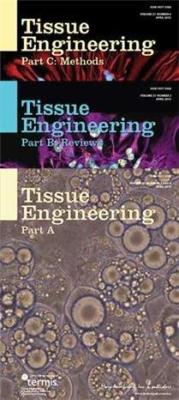Apr 28 2015
Unlike scaffold-based methods to engineer human tissues for regenerative medicine applications, an innovative synthetic material with the ability to self-assemble into nanostructures to support tissue growth and ultimately degrade offers a promising new approach to deliver cell and tissue therapies. The unique properties of this biofunctional coating that enable it to stimulate and direct the formation of complex tissues are described in an article in Tissue Engineering, Part A, a peer-reviewed journal from Mary Ann Liebert, Inc., Publishers. The article is available free on the Tissue Engineering website.
 Tissue Engineering is an authoritative peer-reviewed journal published monthly online and in print in three parts: Part A, the flagship journal published 24 times per year; Part B: Reviews, published bimonthly, and Part C: Methods, published 12 times per year. Led by Co-Editors-In-Chief Antonios Mikos, PhD, Louis Calder Professor at Rice University, Houston, TX, and Peter C. Johnson, MD, Vice President, Research and Development and Medical Affairs, Vancive Medical Technologies, an Avery Dennison business, and President and CEO, Scintellix, LLC, Raleigh, NC, the Journal brings together scientific and medical experts in the fields of biomedical engineering, material science, molecular and cellular biology, and genetic engineering. Tissue Engineering is the official journal of the Tissue Engineering & Regenerative Medicine International Society. Credit: ©Mary Ann Liebert, Inc., Publishers
Tissue Engineering is an authoritative peer-reviewed journal published monthly online and in print in three parts: Part A, the flagship journal published 24 times per year; Part B: Reviews, published bimonthly, and Part C: Methods, published 12 times per year. Led by Co-Editors-In-Chief Antonios Mikos, PhD, Louis Calder Professor at Rice University, Houston, TX, and Peter C. Johnson, MD, Vice President, Research and Development and Medical Affairs, Vancive Medical Technologies, an Avery Dennison business, and President and CEO, Scintellix, LLC, Raleigh, NC, the Journal brings together scientific and medical experts in the fields of biomedical engineering, material science, molecular and cellular biology, and genetic engineering. Tissue Engineering is the official journal of the Tissue Engineering & Regenerative Medicine International Society. Credit: ©Mary Ann Liebert, Inc., Publishers
In "New Self-Assembling Multifunctional Templates for the Biofabrication and Controlled Self-Release of Cultured Tissue ", Ricardo Gouveia, Valeria Castelletto, Ian Hamley and Che Connon, University of Reading Whiteknights Campus, Reading, and Newcastle University, Newcastle upon Tyne, U.K., discuss how a novel synthetic material comprised of peptide amphiphile molecules is able to form a bioactive coating that interacts with cells in the surrounding environment and initiates a signaling cascade resulting in the formation of complex three-dimensional tissue structures that are then released from the coating.
"This article describes investigations towards the development of innovative biomaterials able to direct the formation of complex tissues as well as their release from the biomaterial template with enormous implications in tissue engineering and regenerative medicine," says Co-Editor-in-Chief Antonios Mikos, PhD, Louis Calder Professor at Rice University, Houston, TX.